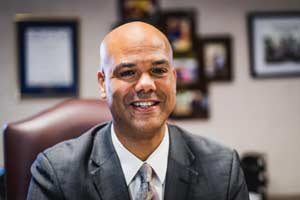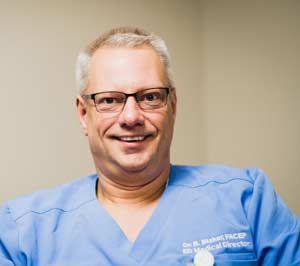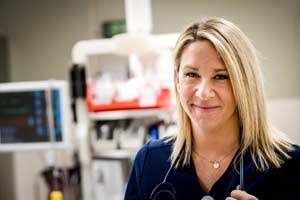A visit to the emergency room can be one of the most stressful, unpredictable, and potentially frustrating experiences of a person’s life.
But a new partnership at McLaren Bay Region, along with a host of patient-centered initiatives, could ease some of that experience as part of an effort to decrease wait times, make diagnosis more efficient and accurate, and improve patient satisfaction.

Clarence Sevillian, President and CEO of McLaren Bay Region.
“We look at emergency services as the frontline of the hospital,” says Clarence Sevillian, president and CEO of McLaren Bay Region. “On the frontline, you need the make the best impression possible to start the patient’s experience off well.”
A new partnership
Sevillian says the most important place to make that impression is through the hospital’s staff, which influences everything from patient wait times and physician accuracy, to whether or not patients feel both physically and emotionally cared for. Securing a partnership with an effective and proven emergency department staffing agency is a critical component to the health of the people a hospital serves.
“We needed to find a partner who shared the same mission, vision, and would be able to improve the metrics McLaren uses to evaluate the efficiency of an emergency department,” he says. “We have found that American Physician Partners is right in line with that.”
American Physician Partners (APP) is an emergency medicine management company focused on providing qualified care providers and management services to hospitals while placing an emphasis on developing local leaders, creating a team-based culture, and establishing long-term stability within a department.
Through APP’s approach to staffing and department culture, Gadsden Regional Medical Center in Gadsen, Alabama, saw a 47 percent decrease in patients who left without treatment, a 34 percent reduction in door-to-bedtime, and decreased the average length of stay by 87 minutes.
Along with improving the efficiency and efficacy of the emergency department, Sevillian says McLaren is establishing new initiatives aimed to improve the interactions between physicians and patients.
Improving both physical and emotional care
“Patient satisfaction is extremely important, and that includes the friendliness of our staff and ER physicians,” he says. “We want to give people the reassurance that we’re here to listen, to take care of them, and that they’re not just a number.”
Staff showing empathy towards patients is something that requires skills like actively listening, being engaged, and communicating back to patients what they think is being said, Sevillian says. “Especially in these difficult situations, delivering the message that we care becomes even more important. It bridges the gap between physicians and patients, and even helps the healing process.”

Brad Blaker, DO
Leading the emergency department as medical director, Brad Blaker, DO, comes to McLaren Bay Region from Lapeer with over 20 years of emergency department experience.
“The key part of a medical director’s job is to get physicians, staff, and patients all operating as a team,” Sevillian says. “Dr. Blaker has that ability. He’s able to put on his administrative hat and understand the requirements for all our metrics while making sure things are done right. But more important, he’s able to connect those things to the frontline of the emergency department and everything in between: from what’s happening on the floor, to what’s happening with surgical specialists, to building relationships with patients. Bridging those gaps and executing the various elements across teams takes a certain kind of leader, and Dr. Blaker has demonstrated that he is that kind of leader.”
A new effort to exceed expectations
Walking into the emergency department, Dr. Blaker’s office looks like he doesn’t spend much time there. There are two desks, a small table, and the walls are bare.
Dr. Blaker arrives dressed in scrubs from head to toe. He’s in the middle of a clinical shift, but he settles into a chair, ready to talk.
“I think working clinical shifts is a huge piece of being a site medical director,” he says. “It would be very difficult for me to effect change, see how the providers work, and understand the problems our hospital partners face if I wasn’t working on the floor with them.”
Along with giving perspective to his work as medical director, Dr. Blaker says his hands-on care helps support the message that the emergency department exists for the sole purpose of taking care of people.
“I want to communicate that we are here to take care of patients, and that taking care of patients has to be the primary focus of the nursing staff, the support staff, the provider staff, and everybody who interacts with a patient or a patient’s family in the emergency department.”
An emergency department medical director is responsible for interacting with administration and providers, as well as other departments within the hospital, such as cardiology, OBGYN, and internal medicine, both to coordinate health care efforts as well as to prevent bottlenecks between departments. In Dr. Blaker’s case, he also takes on clinical shifts to continue providing direct patient care.
“I also monitor metrics like throughput times and patients who left-without-being-seen, and as I monitor those metrics, I perform administrative duties to make sure all the providers have the tools they need,” he says.
Dr. Blaker says having a consistent staffing pattern, as well as having effective plans and processes in place are the keys to improving those metrics, especially when the emergency department sees a sudden increase in patients.
“On any given day, we can go from having five patients in the department to having 40 patients within an hour. So what do you do with that volume when it shows up? It’s having the processes in place and the team coming together to push through and take care of the patients.”
Even with all his duties, Dr. Blaker says it’s his responsibility to go beyond the job description.
“One of APP’s goals when it forms a new partnership is to exceed the expectations of patients, providers, and hospital partners,” he says.
He says the department will exceed those expectations with both the physical and emotional care provided to patients.
The changing face of medicine
“The changing face of medicine is all customer-service related,” he says. “It all starts with just being nice. I want that bolstered on the front door of the hospital. I want the staff to be able to communicate to patients that they understand that they’re scared, they’re hurt, and they have concerns because it goes beyond treating patients like customers - it’s just the right thing to do.”
What does Dr. Blaker want these new plans, processes, and patient-centered initiatives to accomplish for the emergency department?
“I want the reputation of the emergency department to be exceptional; this means the reputations of the medical staff, the administration, the community-based physicians. The patients from the community - I want them coming to this emergency department. That’s what I want. I don’t want them to say ‘Fill in the blank’ is better than we are. When they think about emergency services, I want them to think McLaren Bay Region.”
Teamwork

Brooke Getty, RN
Brooke Getty, RN is a registered nurse in the emergency department, and the fast-paced unpredictability is something she loves.
“I love the intensity. It’s so fast-paced, and you have to make quick decisions in order to be there for people in the best and worst times of their lives,” she says.
While that fast-paced intensity can offer a compelling work environment for Getty, she says teamwork is what makes the emergency department a place for life-saving health care instead of chaos.
With the number of people and diversity of roles necessary to create an effective emergency department, Getty says the new partnership with APP and Dr. Blaker’s leadership seem to be strengthening the connections that hold the team together.
“From physicians to clerks, to RNs, to PCAs, the teamwork we have here is outstanding and we could not do our job without it,” she says. “Dr. Blaker brings to the table a new sense of accountability, for everyone from the doctors to the nursing staff, and he’s also put a lot of new initiatives in place, even down to simple things like changing the ergonomics of the doctor’s area. He’s making a lot of changes, and we’re heading in the right direction.”
What does Getty think about Dr. Blaker working side-by-side with her and other care providers on the floor during clinical shifts?
“You really respect someone who can put on a pair of scrubs, get to work, and do all the things they preach,” Getty says. “People stand up taller when he’s around. He commands respect but is still able to work side-by-side with our doctors and nursing staff. I think we’re going to click, and I think he’ll do great things here.”
What to expect
How will a patient’s experience at McLaren Bay Region improve because of this new partnership and these patient-centered initiatives?
“Overall patient satisfaction will improve,” Sevillian says. “The emergency department will feel more friendly, and patients will feel like they’re being listened to and understood.”
Sevillian also says having new leadership and improved teamwork will decrease wait times, total length of stay at the hospital, and improve overall clinical care.
“This is an exciting time for us as we continue to grow and improve to better help the people who are entrusting us with their lives,” he says. “Our partnership with APP and these new initiatives will allow us to serve the community more quickly and more effectively, as well as offer better value and quality.”